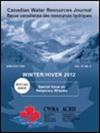冰川对上游阿萨巴斯卡河流域水流贡献的当前和未来预测
IF 0.9
4区 环境科学与生态学
Q3 WATER RESOURCES
引用次数: 15
摘要
摘要加拿大阿尔伯塔省的阿萨巴斯卡河流域具有国际意义,了解供水对该地区的可持续性至关重要。在阿萨巴斯卡河上游流域,冰川覆盖了272 截至2010年,km2(占流域的2.8%),但小于50 预计到21世纪末,面积仍将保持在每平方公里。本研究使用明确说明冰川退缩的水文模型,调查了基线(1981–2010)期间和两种气候变化情景(RCP 4.5和RCP 8.52011–2100)冰川对流量的贡献。模拟的冰川流量(即包括所有冰川冰、冷杉和融雪)占年流量的4%-6%,8月份占基线期流量的20%-30%。该模型预测,未来几十年冰川流量将增加,到21世纪中叶将下降。尽管冰川流量预计在短期内会增加,但除非该地区气温稳定,否则这种水源是不可再生的,目前任何气候模型都没有预测到这一点。虽然阿萨巴斯卡河上游流域的流量预计将按年度时间尺度增加,但夏末月份的流量预计到2100年将减少58%。这些模拟遵循了加拿大西部和全球的研究结果,强调“峰值水量”不仅由冰川流量的变化驱动,还对气候变化做出了反应。夏末是水需求最高的时期,水资源短缺已经发生,水质最敏感,在流域内的水道中航行的能力有限。这些发现强调了流量时间和季节性变化的重要性,并对阿萨巴斯卡河流域和冰川流域其他地区未来几十年的水资源管理提出了重大挑战。本文章由计算机程序翻译,如有差异,请以英文原文为准。
Current and future projections of glacier contribution to streamflow in the upper Athabasca River Basin
Abstract The Athabasca River Basin in Alberta, Canada, is of international significance, and understanding water supply is critically important to the sustainability of the region. In the upper Athabasca River Basin, glaciers covered 272 km2 (2.8% of the watershed) as of 2010, but less than 50 km2 are projected to remain by the end of the twenty-first century. This study investigated glacier contributions to streamflow for a baseline (1981–2010) period and two climate change scenarios (RCP 4.5 and RCP 8.5, 2011–2100) using a hydrological model that explicitly accounts for glacier retreat. Simulated discharge from glaciers (i.e. including all glacier ice, firn and snow melt) contributed 4%–6% of annual streamflow and 20%–30% in August during the baseline period. The model projects an increase in glacier discharge in the coming decades with a later decline by the middle of the twenty-first century. Although glacier discharge is projected to increase in the short term, this water source is non-renewable barring a stabilization of air temperatures in the region, something not currently projected by any climate model. While streamflow in the upper Athabasca River Basin was projected to increase on an annual time scale, streamflow during the late-summer months was projected to decrease by up to 58% by 2100. These simulations follow findings from across western Canada and globally, highlighting that ‘peak water’ is not solely driven by changes in glacier discharge and is also responsive to changes in climate. Late summer is a period when water demands are the highest, water shortages already occur, water quality is the most sensitive and the ability to navigate throughout watercourses in the basin is limited. These findings emphasize the importance of changes in streamflow timing and seasonality and present major challenges for water management in the Athabasca River Basin and elsewhere in glacierized catchments over the coming decades.
求助全文
通过发布文献求助,成功后即可免费获取论文全文。
去求助
来源期刊

Canadian Water Resources Journal
WATER RESOURCES-
CiteScore
2.90
自引率
5.90%
发文量
17
审稿时长
>12 weeks
期刊介绍:
The Canadian Water Resources Journal accepts manuscripts in English or French and publishes abstracts in both official languages. Preference is given to manuscripts focusing on science and policy aspects of Canadian water management. Specifically, manuscripts should stimulate public awareness and understanding of Canada''s water resources, encourage recognition of the high priority of water as a resource, and provide new or increased knowledge on some aspect of Canada''s water.
The Canadian Water Resources Journal was first published in the fall of 1976 and it has grown in stature to be recognized as a quality and important publication in the water resources field.
 求助内容:
求助内容: 应助结果提醒方式:
应助结果提醒方式:


